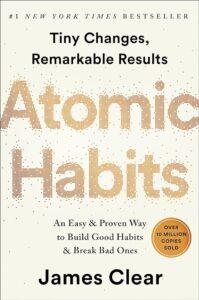Below are materials for a book-based study group. These include a book summary, vocabulary words, discussion questions, and debate topics. Study tools that might be helpful include:
- Automated Text to Speech: Speechify Text to Speech Voice Reader
- Translation: Google Translate
- Two language subtitles for videos: Language Reactor
- For word usage examples: Playphrase.me or Yarn.co
Most of these tools are available as browser extensions on desktops and as apps for mobile devices.
Summary
 James Clear’s “Atomic Habits” is a seminal work that delves into the mechanics of habits and how they shape our lives. The book posits that habits are the building blocks of our daily experiences and that understanding their intricacies is crucial for personal development. Clear argues that the power of habits lies in their compound effect over time, akin to compound interest in finance. Small, incremental changes can lead to transformative results, and this book provides a comprehensive framework for achieving such changes.
James Clear’s “Atomic Habits” is a seminal work that delves into the mechanics of habits and how they shape our lives. The book posits that habits are the building blocks of our daily experiences and that understanding their intricacies is crucial for personal development. Clear argues that the power of habits lies in their compound effect over time, akin to compound interest in finance. Small, incremental changes can lead to transformative results, and this book provides a comprehensive framework for achieving such changes.
The Four Laws of Behavior Change
At the heart of the book is the Four Laws of Behavior Change, a set of principles that serve as a roadmap for habit formation. These laws are designed to make the process of adopting new habits more straightforward and intuitive. They are:
- Make It Obvious: The first law focuses on the importance of cues in habit formation. Clear argues that making the cues associated with a habit more visible can significantly increase the likelihood of performing the habit. For example, if you want to make a habit of taking vitamins, placing the vitamin bottle next to your toothbrush can serve as a visual cue.
- Make It Attractive: The second law revolves around the concept of temptation bundling, which involves pairing a habit you want to adopt with something you already enjoy. This makes the habit more appealing and increases the chances of sticking with it. For instance, if you want to exercise more, you could pair it with watching your favorite TV show, making the experience more enjoyable.
- Make It Easy: The third law emphasizes the importance of simplicity in habit formation. The easier a habit is to perform, the more likely it is to stick. Clear introduces the “Two-Minute Rule” here, suggesting that new habits should be scaled down to actions that can be completed in two minutes or less. This makes it easier to start and lays the foundation for more complex behaviors.
- Make It Satisfying: The fourth law focuses on the immediate rewards that come from performing a habit. Clear argues that the more immediate and satisfying the reward, the more likely the habit is to be reinforced. He suggests using habit trackers or other forms of immediate feedback to make the habit more satisfying to perform.
Identity and Habits
One of the most compelling aspects of “Atomic Habits” is its focus on identity. Clear argues that habits are not merely actions but are deeply tied to our sense of self. He introduces the concept of “identity-based habits,” which shifts the focus from what you want to achieve to who you want to become. This is a powerful reframing because when a habit becomes part of your identity, it is much more likely to stick. For example, if you want to become a writer, you are more likely to stick with a writing habit.
The Compound Effect
The book also delves into the complexities of the compound effect of habits. While small changes may seem insignificant in the short term, their impact over an extended period can be monumental. Clear uses various analogies to drive this point home, such as the trajectory of an airplane. A slight change in direction can lead to a vastly different destination over time. This principle applies to habits as well; small but consistent changes can lead to transformative life outcomes.
Advanced Techniques: Habit Stacking and Environment Design
Clear doesn’t stop at the basics; he also discusses more advanced techniques for habit formation. One such technique is habit stacking, which involves integrating a new habit into an existing routine. For example, if you already have a habit of making coffee in the morning, you could stack a new habit of meditating for two minutes right after you make your coffee. Another advanced technique is environment design, which involves structuring your environment in a way that makes good habits easier and bad habits harder. For instance, if you want to eat healthier, keeping fruits and vegetables at eye level in your fridge can make it easier to make healthy choices.
Breaking Bad Habits
The book also offers a robust section on breaking bad habits. Clear suggests that the Four Laws can be inverted to break a bad habit. For example, making the cues associated with a bad habit less obvious can reduce the chances of performing the habit. Similarly, making a bad habit unattractive, difficult, and unsatisfying can go a long way in breaking it. Clear also emphasizes the importance of replacing a bad habit with a good one, as nature abhors a vacuum. Simply trying to stop a behavior is often not enough; it needs to be replaced with a more positive action.
Conclusion
“Atomic Habits” provides a comprehensive and actionable guide to understanding habits, how they form, and how they can be changed. The book’s strength lies in its scientific approach, practical advice, and focus on the long-term compound effect of habits. By understanding and applying the Four Laws of Behavior Change, focusing on identity-based habits, and employing advanced techniques like habit stacking and environment design, anyone can harness the power of habits to significantly improve their life.
Vocabulary
- Comprehensive
- Covering all or nearly all elements or aspects.
- The comprehensive guide included everything from basic principles to advanced techniques.
- Framework
- A basic structure underlying a system or concept.
- The framework for habit formation helped me understand the key components involved.
- Compound Interest
- The addition of interest to the principal sum, calculated on the initial principal and the accumulated interest.
- Compound interest can lead to exponential growth in your savings over time.
- Ingrained
- Firmly fixed or established.
- The habit became so ingrained that it felt like second nature to me.
- Temptation Bundling
- Pairing an action you want to do with an action you need to do.
- I used temptation bundling to make my workout routine more enjoyable.
- Immediate
- Occurring or done at once.
- The immediate reward made the habit more satisfying to perform.
- Reinforce
- Strengthen or support.
- Tracking my progress helped to reinforce my new habit.
- Identity-Based
- Relating to one’s sense of self.
- Identity-based habits focus on who you want to become rather than what you want to achieve.
- Trajectory
- The path followed by an object moving through space.
- A slight change in trajectory can lead to a vastly different outcome.
- Substantial
- Of considerable importance or worth.
- The substantial benefits of the new habit became apparent over time.
- Integrate
- Combine one thing with another to form a whole.
- I was able to integrate the new habit into my daily routine.
- Surroundings
- The things and conditions around a person or thing.
- Changing my surroundings made it easier to stick to my new habit.
- Indulge
- Allow oneself to enjoy a particular pleasure.
- It’s hard not to indulge in junk food when it’s easily accessible.
- Eliminate
- Completely remove or get rid of.
- To break a bad habit, you need to eliminate the cues that trigger it.
- Substitute
- Replace someone or something with another.
- It’s easier to break a bad habit when you can substitute it with a good one.
Discussion Questions
- Do you agree with the concept that habits are the “compound interest” of self-improvement?
- Which of the Four Laws of Behavior Change do you find most challenging to implement?
- How do you feel about the idea of “identity-based” habits?
- Can you think of a small habit that led to significant changes in your life?
- How can environment design help or hinder habit formation?
- What are some habits you’ve successfully integrated into your life using habit stacking?
- Do you use any form of tracking to reinforce your habits?
- How do you deal with the temptation to revert to bad habits?
- Can you think of a bad habit you’ve successfully broken? How did you do it?
- How do external factors, like social influences, affect your habits?
- Do you think it’s easier to build a new habit or break an existing one?
- What role does willpower play in habit formation?
- How can you apply the “Two-Minute Rule” to a habit you’re trying to build?
- What are some good habits that can lead to substantial improvements in quality of life?
- How do you handle setbacks or failures in sticking to a new habit?
- Can habits be unlearned, or do they just get replaced?
- How do you prioritize which habits to focus on?
- Do you think some people are naturally better at habit formation than others?
- How do you make a habit “attractive” when the activity itself may not be enjoyable?
- What’s the most surprising insight you gained from the book?
Debate Topics
- Is the concept of “identity-based habits” more effective than goal-setting for long-term improvement?
- Does environment design play a more significant role in habit formation than individual willpower?
- Can bad habits be truly eliminated, or can they only be replaced?
- Is the “Two-Minute Rule” an effective strategy for habit formation, or is it too simplistic?
- Do external factors, like societal norms and expectations, unfairly influence our habits?
- Is it ethical to use techniques like temptation bundling to manipulate oneself or others into forming habits?
- Can the principles of habit formation be universally applied, or do they vary from person to person?
Views: 37






Leave a Reply